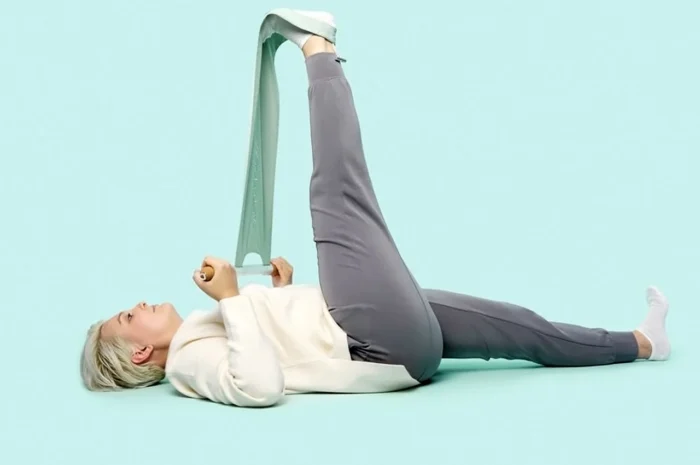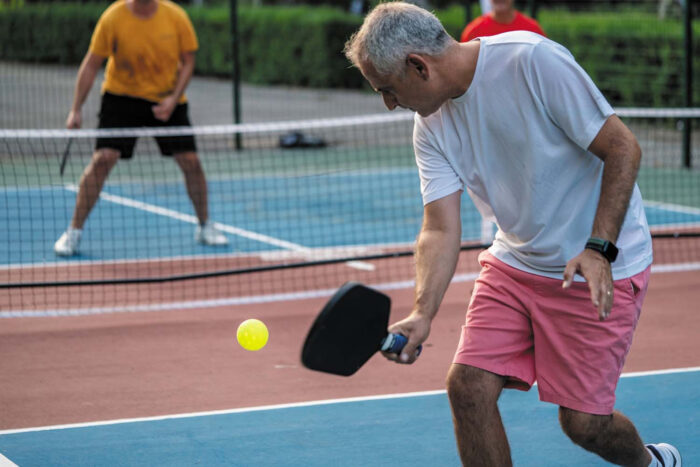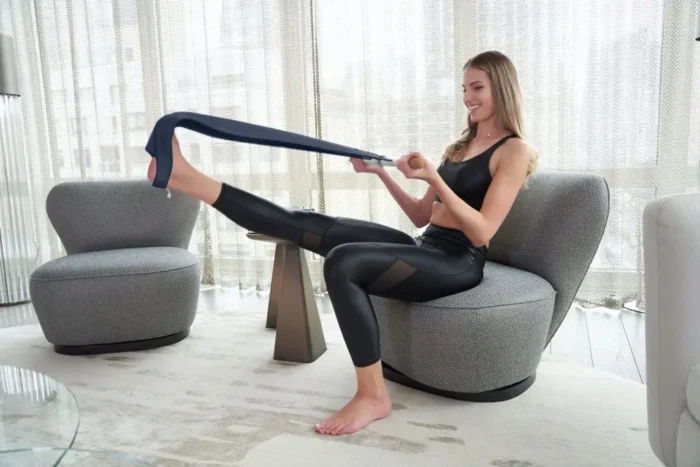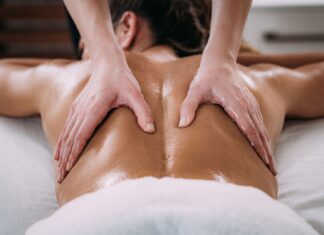
Playing pickleball games with a partner requires skill, strategy, communication – and synced-up flexibility! That vital on-court trust just won’t be there if the partners have prepared differently, or don’t know how the other has prepared, and this will quickly become apparent when your partner isn’t able to do what you expect.
So before you take the court for doubles, make sure you and your teammate warm up properly to align movements and prevent injury. Then you’ll be able to rely on each other when it matters and help each other get to that point of security and competitive edge.
The best way to do this? Follow our 10-minute dynamic stretching routine together. By targeting key muscle groups for pickleball performance we can bring out the best in any willing combination.
Integrating tools like CastleFlexx into partner stretches helps you help each other to safely increase your range of motion. Staying loose and in sync not only leads to better on-court chemistry but emboldens you to push that bit further, when you know you are both comfortable where you are.
Then, when you’ve had your match, you can continue to improve together by using coordinated cooldowns and stretching to foster team bonding and body awareness. Leave it all on the court at the next tournament!
Preparation is Key

While tennis is now taking a backseat to trendier racket sports, doubles pickleball is soaring in popularity – especially amongst older adults seeking fun communal activities that deliver proven cognitive, physical, and social benefits. The game’s smaller court makes rallying exciting without imposing the strain of excessive running.
This enables seniors to enjoy friendly competition while getting heart-healthy cardio. It also helps develop their social interactions, as they are trying to win but are not in adversarial positions.
Don’t be fooled though – just because pickleball goes easier on stamina compared to other racket sports, that doesn’t mean doubles players can overlook stretching and mobility training. The explosive bursts during quick volleys, overhead slamming, and maneuvering body weight from right to left to return difficult shots put substantial stress on key muscle groups.
Powering through matches without properly warming up puts you and your partner at risk of painful muscle tears, ligament sprains, or even bone fractures from the constant starts, stops, lunges, and pivots. That’s why every pickleball pair must take at least 10 minutes before playing games to adequately stretch as a coordinated unit.
Stretching Sync for Injury Prevention

Ideally, all doubles partners will have comparable fitness levels and mobility, so they do not overexert or outpace each other during rallies. It is therefore important for same-age duos with varying tightness or strength imbalances to align their warmup movement patterns with coordinated stretches.
This coordination enables them to identify and then assist with addressing nagging muscle problems by safely opening up a limited range of motion from those tight shoulders, stiff lower backs or rigid hamstring muscles. Having a partner gently stabilize, brace or apply light pressure engages the complementary muscles which will hold the stretch longer for teammates struggling with isolated mobility restrictions.
Unified warmup synchronization pays dividends on the court. When both players know what each has done, and have achieved similar openness and elasticity in their muscles, joints and tendons, both can move in a confident, unhindered manner, rallying, volleying, and scoring effectively as a true doubles team.
Recommended Partner Stretches

Here is a sequence of five partner stretches in which pickleball pairs of any skill level can easily perform courtside before matches. Each addresses the common tight trouble zones that hinder many players’ mobility:
- Assisted hamstring stretching – Here the partners take turns, one gently bracing lower back/postural muscles while the other uses a strap to extend range, pulling from behind, straight, knees up, toward hips/glutes. This facilitates the deeper release of chronically tight hamstrings.
- Rotator cuff twists – In this, each partner in turn maintains a corrections posture whilst slowly rotating the shoulders backward and then forward to the maximum extent. The other partner provides stabilizing resistance to isolate and target the rotator muscles, facilitating smoother overhead swing motions.
- Inner thigh “seated straddle” stretch – In this, both partners perform the same action at the same time. They sit upright a couple of feet apart facing each other, then grasp hands tightly, alternately leaning back to traction those targeted inner thigh and hip abductors open.
- Back and side reaches – Here the partners again alternate, as one begins by standing with their feet just outside their partner’s. They then slowly reach down toward their ankles, as low as comfort allows, while their partner stabilizes their mid and lower back. Then they open their arms out wide, left then right, stretching lats and obliques.
- Neck release stretch – Here the partners work together, standing facing each other shoulder distance apart, clasping each other’s hands palm-to-palm. They slowly press their heads against each other’s hands, alternating directions side-to-side and forward/backward, aiming for mild tension without discomfort.
CastleFlexx for Assisted Stretching
The right stretching device is imperative if you are going to have a beneficial routine that addresses the right areas safely and effectively. Devices like those in the CastleFlexx range give greater boosting and bracing leverage during partner stretches.
The straps on the CastleFlexx devices enable you to simulate the assisted moves that a professional mobility coach or trainer would normally perform, and charge a lot of money for. You can also use your device whenever you like, without having to make an appointment.
The proper use of CastleFlexx on hamstrings provides raised anchor support, so the partners can sink deeper into the stretch, hands-free, once they are in position. This facilitates the visual and verbal communication critical for responsive, controlled stretching between partners.
Remember to breathe fully and relax during the entirety of these partner stretches. Discuss any discomfort immediately, and ease any tension as needed. You can continually challenge yourselves to increase the intensity of the stretches, but only when both partners can improve together at the same pace, not at each others’ expense.
Consistently performing these dynamic stretches, using the right flexibility equipment, will eliminate the weak links in the range of motion between doubles players over time. Building even greater pickleball durability and resilience together can have only one result – at critical moments, you’ll still have the ability to execute, and maybe your opponents won’t!
The wider benefits of greater flexibility on the pickleball court will carry over into daily life too. Those small everyday tasks that others might find cumbersome won’t bother you at all. Get fit to win at pickleball and your achievement can last a lifetime.














